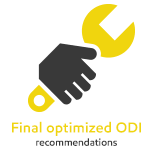
Taking fleets further: The ExxonMobil Optimized ODI Process
Every fleet has different needs. Because of varying truck routes, haul lengths and load weights, custom care is necessary.
That’s why the ExxonMobil Optimized Oil Drain Interval (ODI) Process is driven by data, powered by Mobil Delvac™ lubricants and supported by the ExxonMobil team. The partnership is tailored –fleet by fleet –to make sure that you get the most out of your equipment.

How can it help?
ExxonMobil’s lubricant technology expertise helps fleets extend service intervals, empowering you to:

How does it work?
Establishing fleet maintenance service oil drain intervals is a powerful approach for reducing total cost of ownership, and ExxonMobil works with fleets to determine what’s best for each individual business. With the Optimized ODI Process, you’ll receive a customized preventive fleet maintenance service schedule. But it all starts with identifying potential benefits. Discover how the four-step Optimized ODI Process works:
-

1. Feasibility analysis
First, we evaluate your fleet’s duty cycle and current fleet maintenance practices. We also use Mobil℠ Lubricant Analysis to perform a historical used oil analysis (UOA) review, analyzing data to assess the health of your fleet and the potential to optimize the service intervals. Then, a target Optimized ODI is established and a field test protocol is developed.
-

1. Feasibility analysis
First, we evaluate your fleet’s duty cycle and current fleet maintenance practices. We also use Mobil℠ Lubricant Analysis to perform a historical used oil analysis (UOA) review, analyzing data to assess the health of your fleet and the potential to optimize the service intervals. Then, a target Optimized ODI is established and a field test protocol is developed.
-

2. Documenting performance via field testing
Next, we target the trucks that are most representative of your fleet’s duty cycle(s) and institute the recently developed field test protocol. This protocol typically includes a UOA sampling regimen to gather meaningful data on the stress placed on your fleet.
-

3. Evaluating results
Finally, the UOA test results are analyzed, revealing the impact that different engine technologies, your specific duty cycle and Mobil Delvac engine oil technology have on your fleet’s preventive maintenance program. ExxonMobil technical experts offer their final Optimized ODI recommendations and establish an oil analysis regimen for program stewardship. Occasionally, a visual inspection may be performed to validate your equipment’s capability to operate on these new recommendations.

4. Staying connected
Long after the testing data is reviewed and the final recommendations are made, ExxonMobil’s fleetmaintenance program is there to safeguard your fleet’s success. Customers enrolled in the Optimized ODI Process continue to benefit from:
- Periodic reviews to ensure business objectives are being met and to identify changes in the fleet’s duty cycle.
- Customized UOA progress reports to uncover continuous improvement opportunities.
- Ongoing education and training on the Optimized ODI Process.
Jim Johnston, National Reliability Manager
Kevin Buss, Director of Fleet Maintenance
Steve Duley, VP Purchasing




